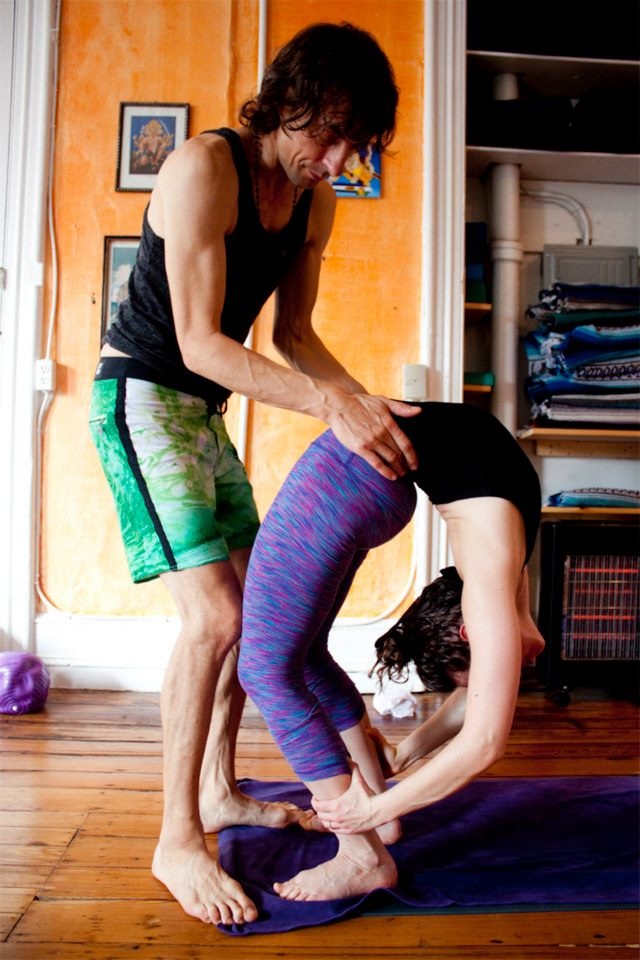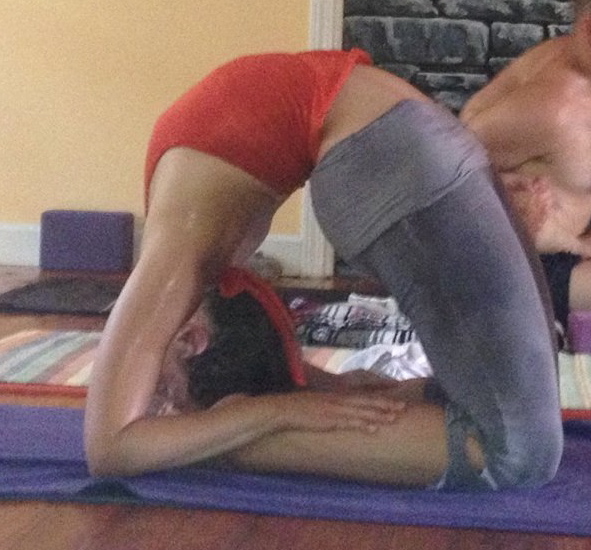It took less than three minutes of Facebook to annoy the namaste out of me after having indulged in a week-long Facebook-free skiing spree in Colorado. Almost as soon as I revived my phone upon landing, it dawned on me:
If I have to see another photo of some hot blond balancing on her elbows in some forearm stand/scorpion variation, I’m going to puke. If I see another photo of you, insane yoga girl, in a bikini-ed-up handstand — with cowboy boots on your sky-reaching feet, no less — I’m going to hurl. And dudes, you’re not getting off here, either. I mean, there you all are, always shirtless, always tattooed, always looking like your very essence forms from a precise mix of ink and abs, which of course always takes the shape of a handstand. Yeah, oh, and there you are AGAIN hot blond on your elbows again for crissakes, and now I’m going to spew, I’m going to un-like you, I’m going to hide you from my newsfeed, I’m going to barf displeasure, a million meaningless hashtags hurling from my mouth out into infinity whenever I think of you and your perfect (or not so much, sometimes, sorry) form in some pose that I can’t do, or can’t do like you, or can’t do looking like you, even where just the hair is concerned, or the tattoos, or even if I could (where the asana or the hair is concerned– I’ll take either), I couldn’t get a photograph of the event because the camera and storage settings on my battered iphone are still a mystery to me, and I don’t have a photographer trailing my every move as I practice, or a faithful yoga assistant ready for a spontaneous inversion photo as we pause during our lovely walk down the street in a disgustingly beautiful and exotic location, like the market in Bali, perhaps…no wait, how about here, in the snow…and here, on this big city street, and of course why not here, on the highway, in the midst of standstill gridlock? Have I mentioned that this onslaught of barftastic yoga photos took only a minute of Facebook perusal to overload me?
I know. The problem wasn’t the hot blond on her elbows (I hid her anyway). And no, the problem wasn’t the famous teacher handstanding in her cowboy boots, either (i decided to give her a pass), or even the shirtless tattooed dude. No, the problem was me. Sigh. Too much facebook, too much online time, too, too, too much– a break is not enough, clearly, I need a whole new regimen. And then, the obvious problem you’re thinking of right now. Was I a little jealous? Sure. You got me. I wish I had that sidekick photographing all my yoga heights, and I wish all my yoga heights looked as photogenic as yours, handstand-hashtag-ista. But it’s more than that.
I imagine some of my online yoga teacher friends might read this and wonder, angrily, perhaps, is she talking about me? The answer is No. The answer is Yes. No. Maybe. No. Really, No.
Actually, I’m talking about me. Because, as you may be the first to point out, I post yoga photos too, and videos, notwithstanding my lack of yoga fame, a personal photographer or assistant, and in spite of my plentiful smartphone incompetence. And I can imagine you all groaning with each glance at my feed, thinking…Ugh! there she is, in a backbend AGAIN. I mean we get it, JM, you can bend in half, so just spare me, OKAY?
The unfortunate fortunate side effect of delving into yoga is that the oft-repeated maxims “All is one” and “I am that” turn out to be proven time and time again, to be true. Because as I recoil repulsed at the photos of you, I see it is only because you are reflecting pieces — and sometimes whole chunks– of me. And so, to fix my burning eyes, it turns out I’m going to have to start with me.
When is it appropriate to post yoga photos and videos? Or what makes them meaningful? #inversionsmakeyouhot girl, you have inspired me to look at what actually makes this stuff matter for me.
Struggle. I am interested in your struggle. Because when I see photo after photo of you in some advanced variation punctuated only by vapid hastags I feel bereft.
Frankly, I get bored.
The struggle, where is the struggle? Where is the work, the story, the inner fire that culminated in this beautiful instagram?
“We delight in the beauty of the butterfly but rarely admit the changes it has gone through to achieve that beauty” -Maya Angelou
I remember when a dear mentor yogini (who I had seen in an artful handstand scorpion photo, pre-facebook) stopped class in the midst of (attempted) forearm stand practice. It seemed that few in class were biting. She told us a story about how she used to practice to an audio recording of Sharon Gannon, and whenever the class reached forearm stand, she would fast forward through it.
What? This otherworldly perfect teacher once had fear? Struggle? Obstacles to overcome? It endeared me to her, it made me feel okay about practicing in her classes even though forearm stand (and all upside down poses) remained at that time feared impossibilities. Indeed, I got into my first yoga teacher training by luck, serendipity, having never taken class with it’s leader, the divine Kelly Morris, and when I read her interview in New York Magazine, http://nymag.com/nymetro/health/fitness/features/5394/index3.html, I knew I had made the right decision, because of this, the very end, where this absolutely exquisite creature baldy admits:
“But I have so many more shortcomings than most of my students! You might not see it in class: I’m flying in there. But when it’s over, I’m back to the same struggle. Yes. The same struggle.”
The lesson for me is to avoid posting so many naked end-result photos, or perhaps to only post them with some message about the work it took me to get there. Because I could post my forearm stand (my recent triumph) but wouldn’t it be more interesting to know, and to see, that I started practicing this pose ten long months ago, and it is only after getting over my fear (no small potatoes), followed by months of falling every time I attempted it, then falling every other time, then balancing for the world’s quickest who-am–I-kidding-five-breaths, then falling again, that I finally think I have this pose in my body and mind.
This morning I held forearm stand with ease. No struggle. Later, scrolling through my phone, drinking my acupuncturist’s kidney tonic, I saw my once-hidden blond yoga chick on her elbows –AGAIN– and managed to smile. I saw, with peaceful clarity, that I was smiling back at ME. And despite her constant slew of beachside handstands (and yes, some of those gymnastics are in cowboy boots), I’ve discovered that I need a little sunny famous Kino in my life, because this magnificent –and adorable– yogi readily shares the days and years of practice, dedication, and fear-toppling that her photo-ready feats required. http://kinoyoga.tumblr.com/post/78739179298/ashtanga-yoga-fourth-series-is-one-of-the-most
Sometimes she even posts videos where she falls out of the poses.
I can’t gag at that.
Nope, I’m going to swallow that video and keep it down, hashtags and all, keep it where it can stream and warm and smile me from the inside out.



